PNV J20233073+2046041 mag 6.8
-
Jacques Montier
- Posts: 242
- Joined: Sun May 13, 2012 2:46 pm
Re: PNV J20233073+2046041 mag 6.8
Hello,
20130828_885 Halpha spectrum with C11 and LhiresIII 2400 t/mm
I confirm the double pic shape on the red part of the alpha line as intensity is still increasing.
Cheers,
20130828_885 Halpha spectrum with C11 and LhiresIII 2400 t/mm
I confirm the double pic shape on the red part of the alpha line as intensity is still increasing.
Cheers,
--
Jacques Montier
Societe d'Astronomie de Rennes
IAU code J23
Jacques Montier
Societe d'Astronomie de Rennes
IAU code J23
-
Eric Barbotin
- Posts: 35
- Joined: Wed Jun 05, 2013 7:48 pm
Re: PNV J20233073+2046041 mag 6.8
Comme disaient certains assureurs... je l'aurai un jour, je l'aurai.. et ben je l'ai eu.
A force de réflexion, j'ai trouvé où je merdouillais dans le traitement et voilà... c'est beaucoup plus exploitable que ce que j'avais produit hier.
Yesterday, I don't know why, I did not process correctly. I Make up my mind all the evening and, alleluia, I found what was wrong. Here is a more useful picture.
Eric
A force de réflexion, j'ai trouvé où je merdouillais dans le traitement et voilà... c'est beaucoup plus exploitable que ce que j'avais produit hier.
Yesterday, I don't know why, I did not process correctly. I Make up my mind all the evening and, alleluia, I found what was wrong. Here is a more useful picture.
Eric
- Attachments
-
- nova del2013-08-26_846.png (8.48 KiB) Viewed 9263 times
-
Christian Buil
- Posts: 1432
- Joined: Mon Sep 26, 2011 6:59 pm
- Contact:
Re: PNV J20233073+2046041 mag 6.8
Eric B, c'est un superbe spectre des raies du Ca II que tu présente là !!!
Maintennt que tu a trouvé le truc, je pense que tu devrais continuer à surveiller cette région.
De mon coté,
An Alpy 600 spectrum taken last light (August 28.99) on 200 mm telescope (14 x 50 s exposure):
Un spectra Alpy 600 pris la nuit dernière (28.99 aout) avec un telescope de 200 mm (exposition de 14 x 50 sec) :

The spectrograph is pushed down to 3650 A.
J'ai exploité assez loin dans l'UltraViolet, jusqu'à 3650 A. D'après ce que me donne l'étoile de référence
(HD196544) c'est je crois encore valable je pense.
The same night I have taken an eShel spectrum:
La même nuit j'ai obtenu un spectre échelle :

On the same graph, the Alpy and the eShel spectra (for the comparison, the spectral
resolution of eShel is modified to match Alpy):
Sur le même graphe, les spectres Alpy et eShel (j'ai dégradé la résolution (numériquement) du
spectre eShel pour l'ammener à celle du spectre Alpy 600) :

The spectra are very similar. Here some details:
La correspondance est très correcte. Quelques détails :


By curiosity, the obseved reference star (HD196544) compared to MILES spectrum of the same star:
Par curiosité, le spectre observé de l'étoile de référence (HD196544) comparé au spectre MILES du même
objet :

Detail of UV part:
Détail de la partie UV :

Christian
Maintennt que tu a trouvé le truc, je pense que tu devrais continuer à surveiller cette région.
De mon coté,
An Alpy 600 spectrum taken last light (August 28.99) on 200 mm telescope (14 x 50 s exposure):
Un spectra Alpy 600 pris la nuit dernière (28.99 aout) avec un telescope de 200 mm (exposition de 14 x 50 sec) :

The spectrograph is pushed down to 3650 A.
J'ai exploité assez loin dans l'UltraViolet, jusqu'à 3650 A. D'après ce que me donne l'étoile de référence
(HD196544) c'est je crois encore valable je pense.
The same night I have taken an eShel spectrum:
La même nuit j'ai obtenu un spectre échelle :

On the same graph, the Alpy and the eShel spectra (for the comparison, the spectral
resolution of eShel is modified to match Alpy):
Sur le même graphe, les spectres Alpy et eShel (j'ai dégradé la résolution (numériquement) du
spectre eShel pour l'ammener à celle du spectre Alpy 600) :

The spectra are very similar. Here some details:
La correspondance est très correcte. Quelques détails :


By curiosity, the obseved reference star (HD196544) compared to MILES spectrum of the same star:
Par curiosité, le spectre observé de l'étoile de référence (HD196544) comparé au spectre MILES du même
objet :

Detail of UV part:
Détail de la partie UV :

Christian
-
Jacques Montier
- Posts: 242
- Joined: Sun May 13, 2012 2:46 pm
Re: PNV J20233073+2046041 mag 6.8
Bonsoir à tous,
Éric, pourrais-tu nous en dire un peu plus sur la méthode que tu as employée pour obtenir le spectre ?
Cela pourrait m'être bien utile...et peut-être à d'autres aussi
Merci d'avance,
Cordialement,
Éric, pourrais-tu nous en dire un peu plus sur la méthode que tu as employée pour obtenir le spectre ?
Cela pourrait m'être bien utile...et peut-être à d'autres aussi
Merci d'avance,
Cordialement,
--
Jacques Montier
Societe d'Astronomie de Rennes
IAU code J23
Jacques Montier
Societe d'Astronomie de Rennes
IAU code J23
-
Jacques Montier
- Posts: 242
- Joined: Sun May 13, 2012 2:46 pm
Re: PNV J20233073+2046041 mag 6.8
Bonsoir,
20130828_982 spectre de la région du doublet du sodium ; C11 + Lhires 2400
20130828_982 spectre de la région du doublet du sodium ; C11 + Lhires 2400
--
Jacques Montier
Societe d'Astronomie de Rennes
IAU code J23
Jacques Montier
Societe d'Astronomie de Rennes
IAU code J23
-
Olivier GARDE
- Posts: 1269
- Joined: Thu Sep 29, 2011 6:35 am
- Location: Rhône Alpes FRANCE
- Contact:
Re: PNV J20233073+2046041 mag 6.8
Evolution of Halpha line and H beta line during last 48 hours.
In blue : August the 26th
In red : August the 28th


In blue : August the 26th
In red : August the 28th


LHIRES III #5, LISA, e-Shel, C14, RC400 Astrosib, AP1600
http://o.garde.free.fr/astro/Spectro1/Bienvenue.html
http://o.garde.free.fr/astro/Spectro1/Bienvenue.html
-
Eric Barbotin
- Posts: 35
- Joined: Wed Jun 05, 2013 7:48 pm
Re: PNV J20233073+2046041 mag 6.8
Jacques, va voir sur http://www.spectro-aras.com/forum/viewt ... ?f=8&t=689 ; j'ai décrit ma galère et le process suivi. Dans un premier temps, je m'étais arrêté là où je voyais un horrible "P Cyg" ; et puis, j'ai juste réfléchi un peu plus...Jacques Montier wrote:Bonsoir à tous,
Éric, pourrais-tu nous en dire un peu plus sur la méthode que tu as employée pour obtenir le spectre ?
Cela pourrait m'être bien utile...et peut-être à d'autres aussi
Merci d'avance,
Cordialement,
Je crois que la description est suffisante sinon je mettrai d'autres explications.
Eric
-
Jacques Montier
- Posts: 242
- Joined: Sun May 13, 2012 2:46 pm
Re: PNV J20233073+2046041 mag 6.8
Merci Éric !
--
Jacques Montier
Societe d'Astronomie de Rennes
IAU code J23
Jacques Montier
Societe d'Astronomie de Rennes
IAU code J23
-
Paolo Berardi
- Posts: 578
- Joined: Thu Sep 29, 2011 10:51 pm
Re: PNV J20233073+2046041 mag 6.8
Hi all, yesterday we had a chance to take several spectra with Lhires III and 600 l/mm grating from UV to NIR. We tried to follow Christian advice about observing NIR spectral features, very interesting in this phase.
Up to about 7000 A we proceeded in the conventional way. Beyond this limit we interposed a Wratten #25 red filter to avoid 2nd order contamination.
Seven spectra covering about 3700 to 9500 A range. I sent every fits format spectrum to François and I joined them all only for an overall view (they are not taken at the same time, so the spectrum is not strictly real):
http://quasar.teoth.it/html/spectra/Nov ... ug2013.jpg
There are many important features (strong emissions and large absorptions - earth atmosphere?) in infrared part.
This is a 2d spectra comparison between nova and reference star:

Full spectrum divided in five parts:
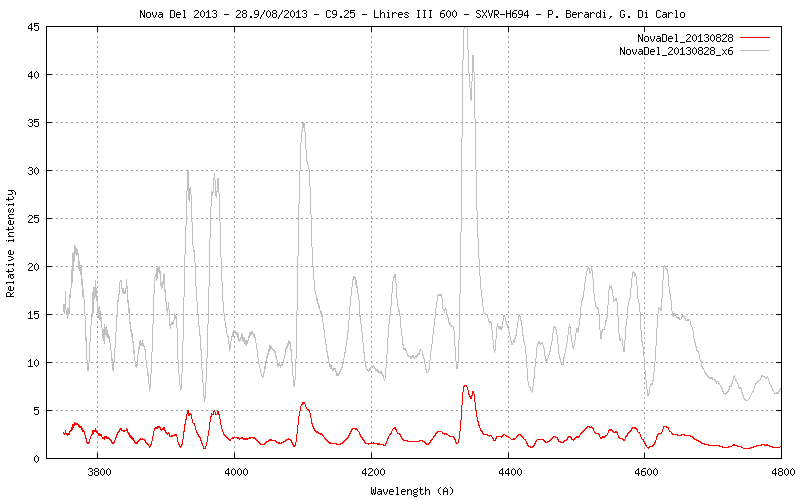
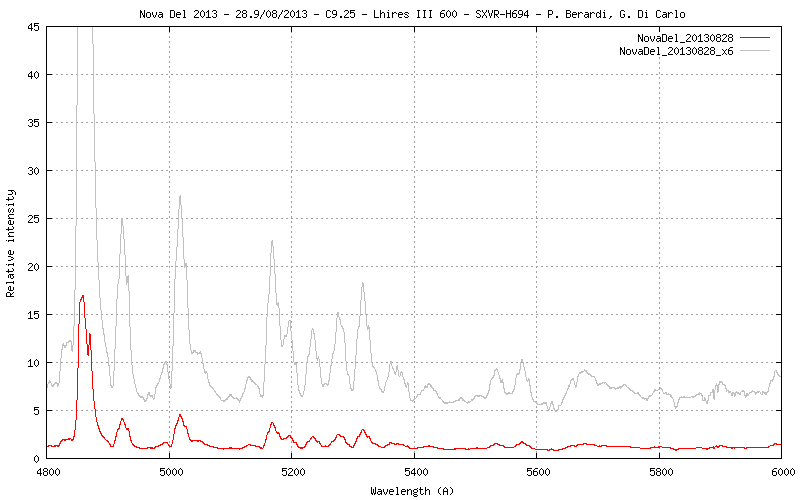
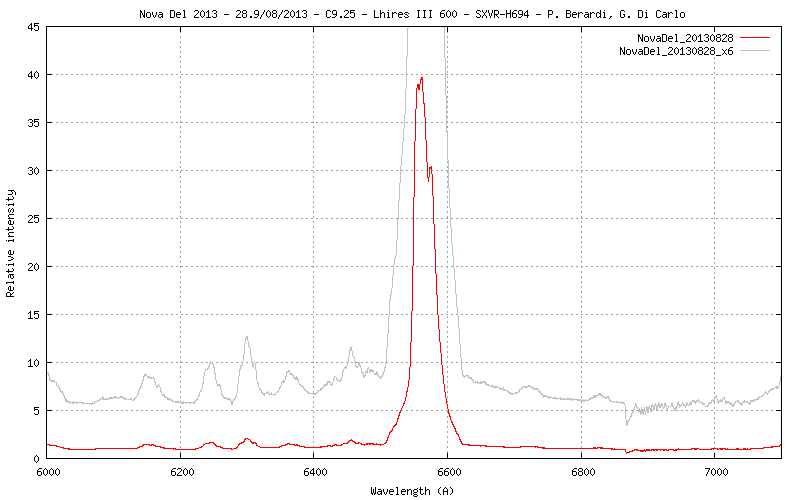
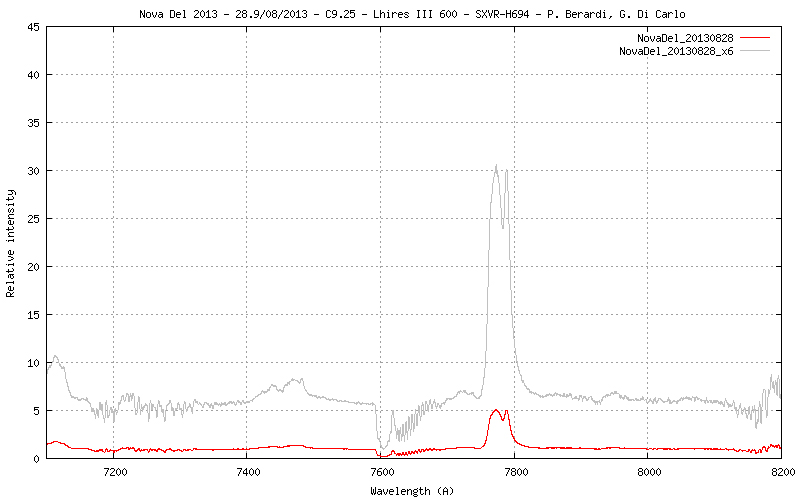
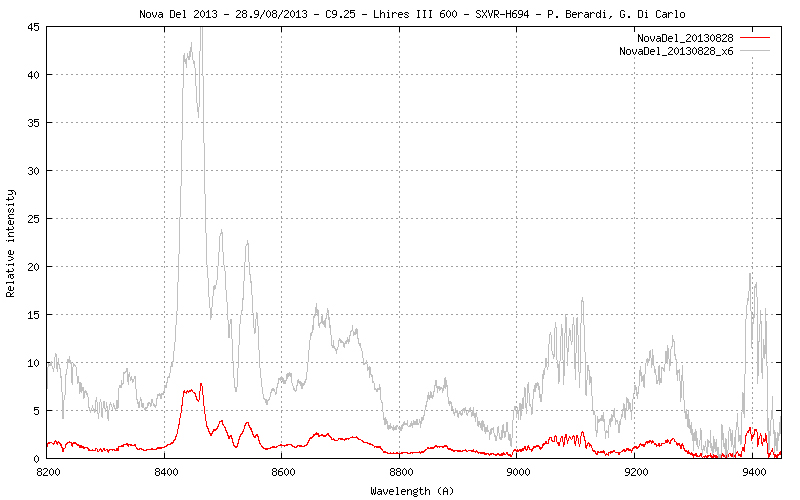
The main difficulty being processed involved continnum correction beyond 7500 A, values not reached by Miles spectrum. I used a Pickles profile chosen with a continuum as similar as possible to Miles reference spectrum. Not very accurate...
Remarkable the higher resolution (about R = 3500) in IR spectral interval. The Lhires III spectrograph performs much better than working in shorter wavelengths (< 4000A).
Unfortunately it is not very easy to do with Lhires III every night...
Ciao!
Paolo
Up to about 7000 A we proceeded in the conventional way. Beyond this limit we interposed a Wratten #25 red filter to avoid 2nd order contamination.
Seven spectra covering about 3700 to 9500 A range. I sent every fits format spectrum to François and I joined them all only for an overall view (they are not taken at the same time, so the spectrum is not strictly real):
http://quasar.teoth.it/html/spectra/Nov ... ug2013.jpg
There are many important features (strong emissions and large absorptions - earth atmosphere?) in infrared part.
This is a 2d spectra comparison between nova and reference star:

Full spectrum divided in five parts:





The main difficulty being processed involved continnum correction beyond 7500 A, values not reached by Miles spectrum. I used a Pickles profile chosen with a continuum as similar as possible to Miles reference spectrum. Not very accurate...
Remarkable the higher resolution (about R = 3500) in IR spectral interval. The Lhires III spectrograph performs much better than working in shorter wavelengths (< 4000A).
Unfortunately it is not very easy to do with Lhires III every night...
Ciao!
Paolo
-
Ernst Pollmann
- Posts: 461
- Joined: Mon Sep 26, 2011 7:16 pm
Re: PNV J20233073+2046041 mag 6.8
In order to play further within the concert of these amazing results:
here the (neverending) Halpha growth of this evening.
The "red shoulder" comes more and more significant.
I am curious what the expert´s explanation regarding of this separation of two velocity areas is.
Ernst
here the (neverending) Halpha growth of this evening.
The "red shoulder" comes more and more significant.
I am curious what the expert´s explanation regarding of this separation of two velocity areas is.
Ernst
- Attachments
-
- novadel2013.png (48.67 KiB) Viewed 9215 times